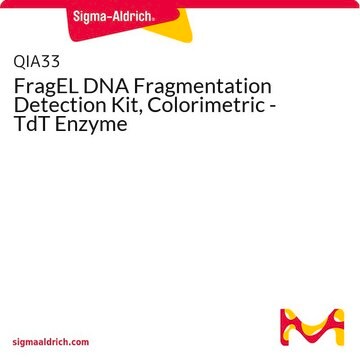Kluczowe dokumenty
11684809910
Roche
Zestaw do wykrywania śmierci komórek in situ, AP
sufficient for ≤50 tests, kit of 1 (3 components), suitable for detection
Synonim(y):
zestaw śmierci komórkowej
Wybierz wielkość
2800,00 zł
Wybierz wielkość
About This Item
2800,00 zł
Polecane produkty
zastosowanie
sufficient for ≤50 tests
Poziom jakości
opakowanie
kit of 1 (3 components)
producent / nazwa handlowa
Roche
metody
immunohistochemistry: suitable
Zastosowanie
detection
temp. przechowywania
−20°C
Powiązane kategorie
Opis ogólny
Contents:
- Enzyme Solution (TdT)
- Label Solution (fluorescein-dUTP)
- Converter AP (anti-fluorescein antibody-AP), ready-to-use
Specyficzność
Zastosowanie
- Detection of individual apoptotic cells in frozen and formalin-fixed tissue sections in basic research†[1][2]
- Determination of sensitivity of malignant cells to drug-induced apoptosis in cancer research[3]
- Typing of cells undergoing cell death in heterogeneous populations by double staining procedures
Cechy i korzyści
- Sensitive: The maximum intensity of labeling (cell staining) of apoptotic cells is higher than the nick translation method
- Fast: The use of fluorescein-dUTP allows analysis of the samples directly after the TUNEL reaction, but before the addition of the secondary detection system
- Convenient: The direct labeling procedure using fluorescein-dUTP allows verification of the efficiency of the TUNEL reaction during the assay procedure
- Accurate: Identification of apoptosis at a molecular level (DNA-strand breaks) and identification of cells at the very early stages of apoptosis
- Flexible: No substrate included; provides the opportunity to select the staining procedure of choice
Opakowanie
Charakterystyka techniczna
The hallmark of apoptosis is DNA degradation, which in early stages is selective to the internucleosomal DNA linker regions. The DNA cleavage may yield double-stranded and single-stranded DNA breaks (nicks). Both types of breaks can be detected by labeling the free 3′-OH termini with modified nucleotides (e.g., biotin-dUTP, DIG-dUTP, fluorescein-dUTP) in an enzymatic reaction. The enzyme terminal deoxynucleotidyl transferase (TdT) catalyzes the template-independent polymerization of deoxyribonucleotides to the 3′-end of single- and double-stranded DNA. This method has also been termed TUNEL (TdT-mediated dUTP-X nick end labeling). Alternatively, free 3′-OH groups may be labeled using DNA polymerases by the template-dependent mechanism called nick translation. However, the TUNEL method is considered to be more sensitive and faster.
Sample material: Cytospin and cell smear preparations, adherent cells grown on slides, and frozen and paraffin-embedded tissue sections.
Zasada
Apoptotic cells are fixed and permeabilized. Subsequently, the cells are incubated with the TUNEL reaction mixture that contains TdT and fluorescein-dUTP. During this incubation period, TdT catalyzes the addition of fluorescein-dUTP at free 3′-OH groups in single- and double-stranded DNA. After washing, the label incorporated at the damaged sites of the DNA is marked by an anti-fluorescein antibody conjugated with the reporter enzyme alkaline phosphatase. After washing to remove unbound enzyme conjugate, the AP retained in the immune complex is visualized by a substrate reaction.
Uwaga dotycząca przygotowania
Mix well to equilibrate components.
Storage conditions (working solution): TUNEL reaction mixture
The TUNEL reaction mixture should be prepared immediately before use and should not be stored. Keep TUNEL reaction mixture on ice until use.
Converter-AP
Once thawed the Converter-AP solution should be stored at 2 to 8 °C (maximum stability
6 months).
Note: Do not freeze.
Inne uwagi
Tylko elementy zestawu
- Enzyme Solution (TdT)
- Label Solution (fluorescein-dUTP)
- Converter AP (anti-fluorescein antibody-AP) ready-to-use
Hasło ostrzegawcze
Danger
Zwroty wskazujące rodzaj zagrożenia
Zwroty wskazujące środki ostrożności
Klasyfikacja zagrożeń
Aquatic Chronic 2 - Carc. 1B Inhalation - Skin Sens. 1
Kod klasy składowania
6.1D - Non-combustible acute toxic Cat.3 / toxic hazardous materials or hazardous materials causing chronic effects
Klasa zagrożenia wodnego (WGK)
WGK 3
Temperatura zapłonu (°F)
does not flash
Temperatura zapłonu (°C)
does not flash
Wybierz jedną z najnowszych wersji:
Masz już ten produkt?
Dokumenty związane z niedawno zakupionymi produktami zostały zamieszczone w Bibliotece dokumentów.
Klienci oglądali również te produkty
Produkty
Cellular apoptosis assays to detect programmed cell death using Annexin V, Caspase and TUNEL DNA fragmentation assays.
Testy apoptozy komórkowej do wykrywania zaprogramowanej śmierci komórki przy użyciu aneksyny V, kaspazy i testów fragmentacji DNA TUNEL.
Nasz zespół naukowców ma doświadczenie we wszystkich obszarach badań, w tym w naukach przyrodniczych, materiałoznawstwie, syntezie chemicznej, chromatografii, analityce i wielu innych dziedzinach.
Skontaktuj się z zespołem ds. pomocy technicznej










